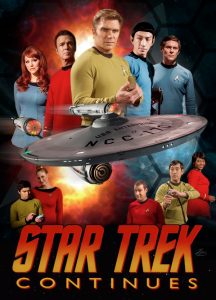I always found it eerily appropriate that this two-word piece of dialog, spoken by Captain Kirk at the end of the final TOS episode “Turnabout Intruder” in 1969, was the last line uttered for the entire original Star Trek series run.
“If only…”
Kirk was referring to the tragic descent into hate-filled insanity of his former love, Dr. Janice Lester. But for me, these two words were so much more powerful: If only Star Trek hadn’t been canceled. If only Star Trek could have…
…continued.
Of course, Star Trek ultimately did continue: a brief animated series in 1973-74, a dozen feature films, five sequel/prequel series, countless novels, manuals, fanzines…and of course, fan films. But “if only…”
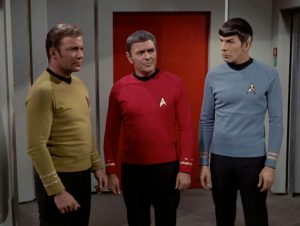
We’ll never see that fourth or fifth season of the original series…at least not on those original sets with a young and vibrant William Shatner, Leonard Nimoy, et al. And despite the noble endeavor that was the animated series, it just wasn’t quite the same feeling I got when I watched those original 79 episodes again and again and again during the 1970s.
Occasionally during my five decades of life, I’d have a dream where I’d be watching a TOS Star Trek episode that I’d never seen before. Usually in the dream, I’d wonder how I could have possibly have missed this unwatched episode after so many decades of viewing reruns. And of course, I’d wake up and realize that, no, I’d never recapture that same sense of excitement and nostalgia that seeing a new episode of TOS had brought me in my youth.
Or so I thought…
It happened 31 minutes into the first full-hour episode of the fan series Star Trek Continues…an episode titled “Pilgrim of Eternity.” The moment lasted only about a minute and a half, but there it was: that feeling! It was the same feeling I’d had when watching a TOS episode for the first time! It was, quite literally, the feeling I’d been dreaming about for decades.
The first half hour of the episode was enjoyable and intriguing, a very decent fan effort. I found myself liking this new series as much if not more than most of the other fan productions I’d seen up to that point. (I’d say SPOILER ALERT, but this episode came out three years ago, people!) But at the midway point of the episode, where the god Apollo suddenly strengthens and turns his powers on Kirk, in that moment I suddenly forgot I was watching a fan film and, if only for a moment, I immersed myself in the belief that I was watching a never-before-discovered “lost” episode of TOS Star Trek.
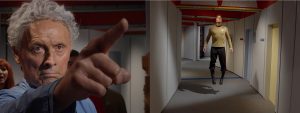
Oh, of course I realized in my head that the actors were different (except for Apollo). If you fault fan films for not featuring young William Shatners and Leonard Nimoys, then you’re never going to be happy. So I always give these fan efforts the benefit of the doubt. But in that moment when I heard Apollo’s voice reverberate, saw Kirk tossed into the air like a rag doll, and listened to that familiar music, it didn’t matter that it wasn’t William Shatner hitting the floor and being levitated. In those 90 seconds, in my heart, I was watching “pure” Star Trek.
Now, before I go any further, I need to address the 800-pound mugato in the living room: Star Trek: New Voyages, the “granddaddy” of fan films and the other major production that attempts to recreate TOS on meticulously-constructed sets with screen-accurate uniforms and new actors playing Kirk, Spock, McCoy, and the rest. Although this particular blog entry is about Star Trek Continues (New Voyages got its spotlight a few months ago), let me state for the record that just because I say something positive about STC, it does NOT mean I’m implying anything negative about NV. This is not a competition any more than the braised chicken at a buffet is competing against the sea bass (both of which I enjoyed this past New Year’s Eve, by the way). You’re allowed to love both series…and I heartily do!
Indeed, STC “stood on the shoulders of giants,” as it were, in following the path blazed by New Voyages and its show-runner, James Cawley. New Voyages proved that it could be done, and done well: recreating TOS sets and costumes, inviting Trek veterans to reprise their roles, using actual Trek writers, and a host of other details to make a great TOS fan series. In fact, Vic Mignogna, the driving force behind STC, actually worked first on NV, directing and guest-starring in one of their most ambitious productions, an episode called “Kitumba.”
Okay, back to STC…
Star Trek Continues grew out of the Starship Farragut fan series after Vic Mignogna directed the third full-length episode of the Farragut series, in which he also played a cameo role of Captain James T. Kirk. Securing additional backing from Dracogen Strategic Investments in late 2011, Farragut Films moved into a much larger studio in Kingsland, GA and expanded their sets to include nearly every USS Enterprise interior that existed at Desilu studios back in the 1960s.
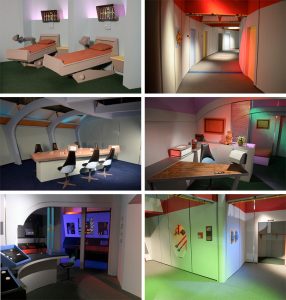
The concept of Star Trek Continues (as the title would imply) was completing the final two years of Kirk’s original 5-year mission as though Star Trek continued without being canceled.
Although Star Trek: New Voyages/Phase II had already been doing essentially the same thing since 2004, Vic’s vision was slightly different. New Voyages had done a stupendous job of recreating the TOS sets and costumes and characters. But they also made a decision after their earliest episodes to film in widescreen format (unlike the 4:3 aspect ratio of 1960s-era TV shows) and to use 3D visual effects shots that were much more dynamic and elaborate than anything that would have been possible with physical models 45-50 years ago.
Star Trek Continues, however, would endeavor to look exactly like the original series episodes, including the smaller aspect ratio. And even though digital CGI effects would be used (created initially by Gabe Koerner and later by Star Trek and Battlestar Galactica 3D artist Doug Drexler), the angles and motions of the Enterprise and other vessels would look straight out of the late 60s.
But it didn’t stop there. Vic Mignogna will be among the first to tell people who enjoy STC that the series owes its success to a lot more people than just him. STC is filled with dedicated fans who do professional-level work out of a love for this legendary franchise. I could spend several blogs just talking about the many folks who make STC possible, but I want to shine a special light (pun intended) on Director of Photography Matt Bucy to give you an idea of why it is that STC looks so close to the original Star Trek series.
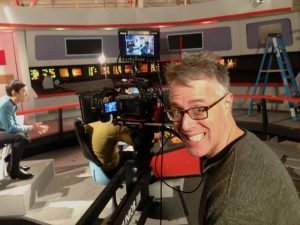
A resident of Vermont, the self-taught cinematographer has to fly down to Kingsland, GA to work his magic on STC (Matt is also a recreational pilot, but I suspect he flies commercial to get to Georgia). And part of that magic is lighting the STC sets the exact same way that the original sets were lit. Now, you might be thinking, “Oh, that sounds so easy.” You’d be wrong!
Working closely with Vic, Matt carefully examined more than three thousand still images from multiple TOS season two and three episodes, trying to figure out precisely how the scenes and characters were lit. In an interview on the STC website, Matt commented, “One trick that directors of photography use is to look at the eyeballs of the actors. If you study them carefully, you can see a big dot that is reflecting the key light. You can see how a light will pick up the hair and shoulders.”
But it wasn’t as simple as just looking at eye reflections. Lighting on sets creates shadow and depth, can add color, and even provide texture on areas that would otherwise look flat if lit incorrectly. Matt continued, “It’s basically stage lighting, using hard light – a key light, a fill light, and a backlight. So we’re using a lot of light sources. When you look at the 1960’s series with a critical eye on lighting, you’ll notice that they didn’t care much about multiple shadows. In fact, I think that’s one of the things that makes our production feel so similar – because there are shadows everywhere! Light is coming from above, usually at a 45-degree angle with the actors. And there are certain facial shadows that give Star Trek Continues a very ‘classic Trek’ look.”
Of course, the lights need something to actually illuminate, and in that department, Matt Bucy was also instrumental. Did I mention that this lighting and cinematography guy, in addition to being a pilot, is also an architect and electronics wiz? (He’s also a real estate developer, if you’re curious.) But when it came to architecture, his expertise allowed the construction team to recreate the exact layout of the original Trek sets as they fit together on Stage 9 at Desilu Studios back in the 1960s. Take a look at this amazing walk-through of their sets.
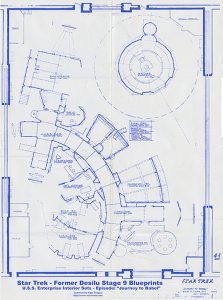 If you look around the Internet, you can find a lot of overhead diagrams showing how the original sound stage was laid out. But those diagrams weren’t full blueprints and lacked accurate measurements. Matt Bucy fixed that. In fact, in planning out the exact measurements of the corridors to the inch, Matt was able to extrapolate how high to build the spires that extend above the sets to hold the lights. Interestingly, doing the analysis of the lighting from the original series helped inform the architecture of the STC sets, and building the sets in turn helped determine the lighting. Matt’s exacting blueprints allowed Michael Bednar and the Farragut Films set construction crew to build a USS Enterprise interior nearly identical to what existed fifty years ago in Hollywood.
If you look around the Internet, you can find a lot of overhead diagrams showing how the original sound stage was laid out. But those diagrams weren’t full blueprints and lacked accurate measurements. Matt Bucy fixed that. In fact, in planning out the exact measurements of the corridors to the inch, Matt was able to extrapolate how high to build the spires that extend above the sets to hold the lights. Interestingly, doing the analysis of the lighting from the original series helped inform the architecture of the STC sets, and building the sets in turn helped determine the lighting. Matt’s exacting blueprints allowed Michael Bednar and the Farragut Films set construction crew to build a USS Enterprise interior nearly identical to what existed fifty years ago in Hollywood.
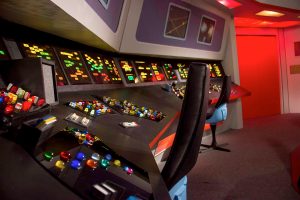 On the electronics side of things, Matt also created the lights that blink behind all the consoles of the bridge. Matt provided some insight in his interview: “Those are not random lights. They play in a sequence. Will Smith, our prop master and resident set expert, and I hope to upgrade the bridge set in the future to precisely match the patterns that illuminated on the backlit bridge panels. That’s a project on our wish list for the future.”
On the electronics side of things, Matt also created the lights that blink behind all the consoles of the bridge. Matt provided some insight in his interview: “Those are not random lights. They play in a sequence. Will Smith, our prop master and resident set expert, and I hope to upgrade the bridge set in the future to precisely match the patterns that illuminated on the backlit bridge panels. That’s a project on our wish list for the future.”
Indeed! In the meantime, other “little touches” abound in Star Trek Continues, some easier to notice than others. For example, it’s pretty obvious that the earliest episodes used much of the music and sound effects in the original Star Trek. But what you probably won’t notice unless you look closely is that the blocking of the actors (where they stand in a scene) is purposefully done to mimic what was done 50 years ago, as is the acting style. It’s not just that the actors (who are all professional) are doing impressions of Shatner, Nimoy, Kelley, and the rest. The actors are working very hard to move their bodies, manipulate their facial expressions, and control their vocal delivery to mirror the performances provided back in the 1960s. Modern acting styles can present very different performances that, while still strong and engaging, would not have the same feel as TOS. Likewise are many directing choices, such as cutting to close-up reaction shots with a flourish of incidental music or showing a subtle sideways glance of one character to another.
And if that isn’t enough to impress you, there’s two final touches that are added in postproduction. First, the colors in each scene are super-saturated to have that over-colorful look of the original Star Trek. And second, because Trek was originally filmed on 35mm film and not video, STC digitally adds in a “graininess” during post-production to make the image look a little less “perfect”…and that, my friends, is what makes it come out so perfect!
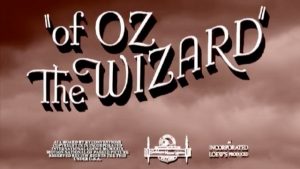 Oh, and since we were talking about Matt Bucy anyway — even though this last item has nothing to do with Star Trek — Matt edited together one of the most mind-blowing head-trips of a video called Of Oz The Wizard . I can’t really describe it, and I’ve only made it through about 54 minutes so far (I’m up to “look”), but I guarantee you’ll want to share it on Facebook! I cannot imagine the amount of work that went into editing this video!
Oh, and since we were talking about Matt Bucy anyway — even though this last item has nothing to do with Star Trek — Matt edited together one of the most mind-blowing head-trips of a video called Of Oz The Wizard . I can’t really describe it, and I’ve only made it through about 54 minutes so far (I’m up to “look”), but I guarantee you’ll want to share it on Facebook! I cannot imagine the amount of work that went into editing this video!
Next time: our focus on Star Trek Continues…er…continues with a look at their early efforts to produce fan films that would raise the bar of quality and fidelity to the source material. We’ll learn a little more about the actors involved and also about what creative decisions were made to move Trek lore forward into what seasons four and five of the original series could have become.
And if you can’t wait, all of the amazing offerings of STC can be found on their website at this page: http://startrekcontinues.com/episodes.html
At the time of this posting, Star Trek Continues has released the following 5 full-length episodes…
Watch “Pilgrim of Eternity” by clicking here.
Rating: HIGHLY RECOMMENDED +![]()
Watch “Lolani” by clicking here.
Rating: MUST SEE![]()
Watch “Fairest of Them All” by clicking here.
Rating: MUST SEE +![]()
Watch “The White Iris” by clicking here.
Rating: HIGHLY RECOMMENDED +![]()
Watch “Divided We Fall” by clicking here.
Rating: MUST SEE![]()
And added after this article was published…
Watch “Come Not Between the Dragons” by clicking here.
Rating: MUST SEE +![]()
Watch “Embracing the Winds” by clicking here.
Rating: MUST SEE +![]()
Watch “Still Treads the Shadow” by clicking here.
Rating: MUST SEE![]()

